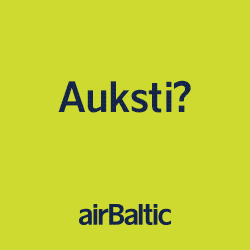Author: airBaltic Corporate Communication Unit
Source: airbaltic.com
The Latvian national airline airBaltic announces that it has exceeded 150 thousand flights operated with the Airbus A220-300 aircraft, since introducing this model to its fleet in 2016. Currently, airBaltic’s single-type fleet consists of 47 aircraft, marking the largest fleet size in the company’s history.
Since the airline’s establishment in 1995, the airBaltic fleet has included various aircraft, such as the Saab 340, Avro RJ70, Fokker 50, Boeing 737-500, Boeing 737-300, Boeing 757-200, Bombardier Q400 NextGen, and Airbus A220-300 (previously known as Bombardier CS300). As from May 2020, airBaltic operates all its flights with a single aircraft type – Airbus A220-300, thus minimizing the complexity and benefiting from the additional efficiency provided by the plane.
Reklāma
Martin Gauss, President and CEO of airBaltic: “Over more than 28 years, airBaltic has experienced significant developments, including an impressive evolution of its fleet. Each aircraft, unique in its characteristics, has contributed to the company's success. However, Airbus A220-300 has been a game-changer for our airline, establishing itself as one of the core assets of the company. With this aircraft, we are now operating one of the most efficient and eco-friendly fleets in the skies, consistently delivering top-tier service to our passengers. Moreover, this year we are looking forward to reaching the milestone of 15 million passengers carried specifically on the Airbus A220-300.”
Thus far, airBaltic has carried approximately 14 500 000 passengers on the Airbus A220-300 aircraft.
In November 2023, the company announced a firm purchase agreement for 30 more Airbus A220-300 aircraft with purchase rights for an additional 20 aircraft of the same type. Therefore, airBaltic plans to operate a fleet of 100 A220-300s by 2030.
Airbus A220-300 offers an excellent flying experience with such benefits for passengers as wider seats, larger windows, more hand luggage space in the cabin, improved lavatories, and delivering better overall performance, fuel efficiency, and convenience for both passengers and the staff.
In addition, the aircraft is also considerably quieter – with a twice times smaller noise footprint when compared to the previous generation aircraft. Moreover, at the moment it is the most efficient commercial aircraft in the world with a transparent declaration of the life-cycle environmental impact, helping to reduce CO2 and NOX emissions by 25% and 50% respectively in comparison with the previous generation aircraft and industry standards.
To publish this article please contact BalticTravelnews.eu editorial board







